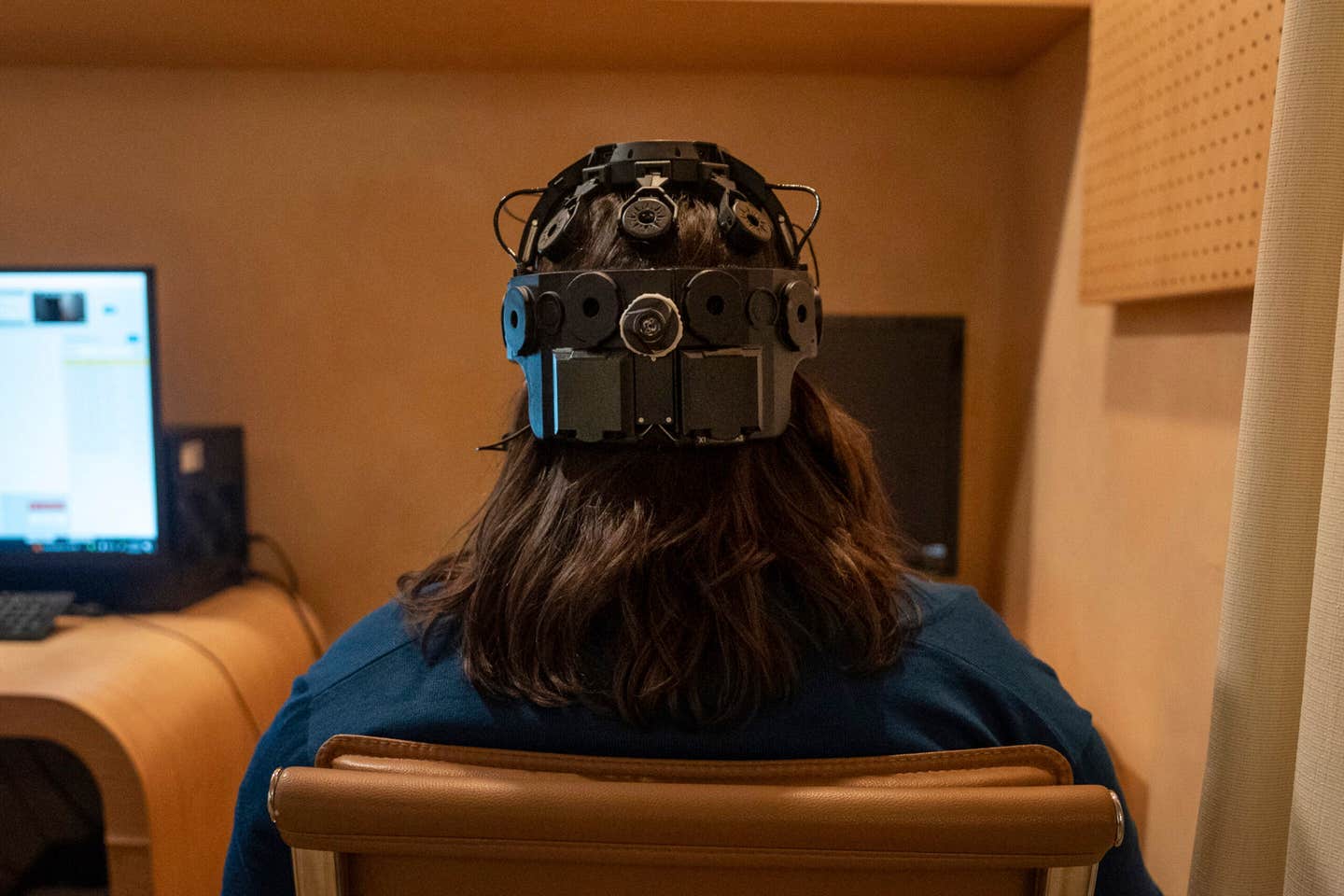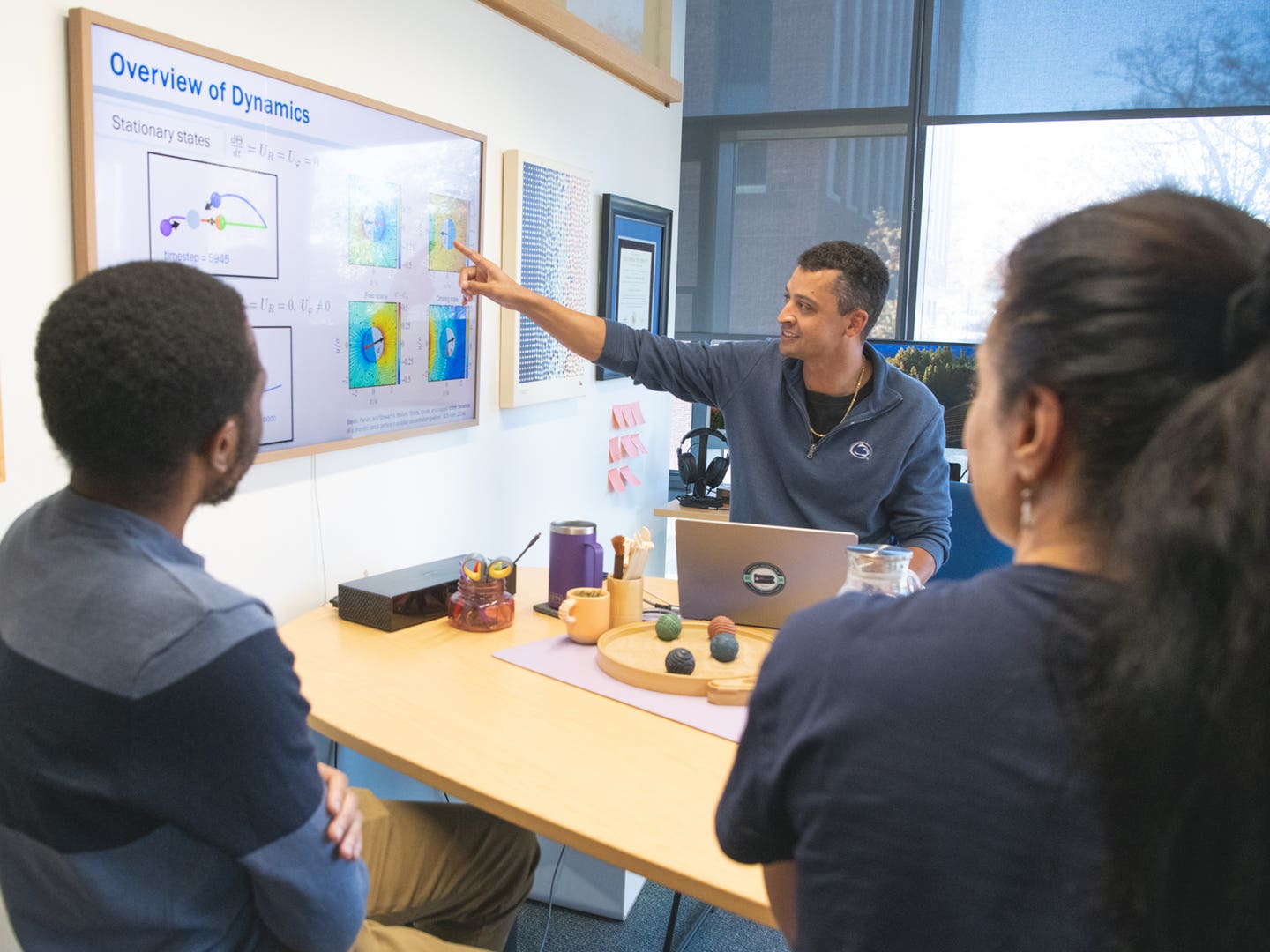Experimental brain pacemaker successfully treats woman with crippling depression
The treatment shows promise for individuals enduring treatment-resistant depression, a condition afflicting nearly 3 million Americans.

Emily Hollenbeck, a deep brain stimulation therapy patient, demonstrates an EEG device that records brain activity as she reacts to short videos at Mount Sinai’s “Q-Lab” in New York. (CREDIT: AP Photo/Mary Conlon)
Emily Hollenbeck, burdened by a profound and recurrent depression akin to being trapped in a gravitational black hole, sought refuge from the looming threat of hereditary suicide by exploring an unconventional therapy.
As first reported by the Associated Press, her desperate journey led her to consider deep brain stimulation (DBS), an experimental treatment showing promise for individuals enduring treatment-resistant depression, a condition afflicting nearly 3 million Americans.
DBS, sanctioned for Parkinson's disease and epilepsy, has instilled hope among both medical professionals and sufferers of depression for its potential expansion in treating this debilitating condition. Administered through electrodes implanted in specific brain regions, DBS delivers targeted electrical impulses akin to a pacemaker for the brain.
Despite encountering setbacks, including studies indicating no discernible advantage for DBS in depression, ongoing research and expedited FDA reviews underscore its potential significance.
Related Stories
Hollenbeck, a participant in Mount Sinai West's research, recalls her initial apprehension toward DBS, likening it to a daunting form of brain surgery. Yet, driven by desperation after exhausting conventional treatments and grappling with a familial legacy of suicide, she embraced DBS as a last resort.
Following her procedure under the skilled hands of Dr. Brian Kopell, director of Mount Sinai's Center for Neuromodulation, Hollenbeck experienced a notable alleviation of her depressive symptoms, describing the sensation as a lifting of the emotional weight that had long plagued her existence.
For Hollenbeck, the transformation brought about by DBS was profound, reigniting her ability to derive pleasure from activities previously shrouded by the bleakness of depression. Recounting her newfound enjoyment of music, once distorted by the disorder, she marvels at the therapy's impact on her quality of life, lamenting its absence during her parents' struggles.
Emily Hollenbeck, a deep brain stimulation therapy patient being treated for depression, stands for a portrait at the American Museum of Natural History's Rose Center in New York. (CREDIT: AP Photo/Mary Conlon)
The historical trajectory of DBS as a depression treatment reflects a journey fraught with both optimism and setbacks. Initial studies led by Dr. Helen Mayberg hinted at its potential efficacy, yet subsequent large-scale trials yielded inconclusive results.
Dr. Katherine Scangos of the University of California, San Francisco, attributes these setbacks to a lack of personalization in treatment and short observation periods. However, recent research suggests sustained relief over extended periods, with response rates averaging 60%, fueling renewed optimism within the scientific community.
Emily Hollenbeck, a deep brain stimulation therapy patient, demonstrates how she makes circles in the air with her arms that are interpreted and projected as light on an interactive wall at Mount Sinai’s “Q-Lab” in New York. (CREDIT: AP Photo/Mary Conlon)
The contemporary landscape of DBS research emphasizes individualized treatment approaches tailored to patients' unique neurophysiological profiles. Mount Sinai's pioneering efforts epitomize this personalized approach, leveraging neuroimaging to pinpoint optimal electrode placement. Dr. Mayberg underscores the significance of individual variability in brain anatomy, advocating for precision in targeting brain regions to optimize therapeutic outcomes.
Despite advancements, skepticism persists among some medical professionals regarding DBS's efficacy and associated risks. Dr. Stanley Caroff of the University of Pennsylvania questions the treatment's scientific foundation, citing uncertainties surrounding the neurobiological underpinnings of depression and the selection of suitable candidates. Amidst these concerns, ongoing clinical trials and regulatory reviews by entities like Abbott offer a glimmer of hope for the treatment's eventual approval and integration into mainstream psychiatric care.
A sample pacemaker-like device, used for deep brain stimulation therapy, and its electrodes which are implanted into a specific site in the brain. (CREDIT: AP Photo/Mary Conlon)
Hollenbeck's journey epitomizes the ongoing quest for progress in depression treatment. Despite DBS's transformative impact, she acknowledges its limitations, emphasizing the need for ongoing medication and therapeutic support.
Collaborative efforts between researchers and patients like Hollenbeck aim to refine treatment protocols and enhance monitoring mechanisms to track long-term progress accurately.
Neuroimaging expert Ki Seung Choi explains how he uses brain scans to locate the exact spot in a particular patient where electrodes for deep brain stimulation therapy should be placed. (CREDIT: AP Photo/Mary Conlon)
Recent advancements in neuroimaging and data analytics offer promising avenues for objective assessment of treatment response and prognosis. Hollenbeck's involvement in data collection and analysis underscores the pivotal role of patient engagement in shaping the future of DBS therapy.
As Hollenbeck navigates her post-DBS life with renewed vigor and resilience, she reflects on the scars left by her journey, both physical and emotional. Yet, amidst the remnants of past struggles, she finds solace in her newfound resilience and the hope that DBS affords individuals grappling with the relentless grip of depression.
For Hollenbeck, DBS is not merely a treatment; it is a lifeline that has granted her a second chance at life.
For more science stories check out our New Discoveries section at The Brighter Side of News.
Note: Materials provided above by The Brighter Side of News. Content may be edited for style and length.
Like these kind of feel good stories? Get the Brighter Side of News' newsletter.
Joshua Shavit
Science & Technology Writer | AI and Robotics Reporter
Joshua Shavit is a Los Angeles-based science and technology writer with a passion for exploring the breakthroughs shaping the future. As a contributor to The Brighter Side of News, he focuses on positive and transformative advancements in AI, technology, physics, engineering, robotics and space science. Joshua is currently working towards a Bachelor of Science in Business Administration at the University of California, Berkeley. He combines his academic background with a talent for storytelling, making complex scientific discoveries engaging and accessible. His work highlights the innovators behind the ideas, bringing readers closer to the people driving progress.



